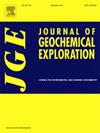中国南方Sb-(Au)矿床成因的微量元素和硫同位素约束:来自龙口矿床的启示
IF 3.3
2区 地球科学
Q1 GEOCHEMISTRY & GEOPHYSICS
引用次数: 0
摘要
中国南方湘中成矿省(XZMP)拥有该地区最广泛的锑多金属成矿系统,包括两种主要矿床类型:纯锑和锑金(W)。为探讨其成因差异,对邵阳盆地龙口SbAu矿床的辉锑矿进行了原位LA-ICP-MS和硫同位素分析,并与已发表的西矿山、道草湾、窝溪和板溪等矿床的辉锑矿资料进行了综合分析。辉锑矿微量元素的多元统计分析(PCA和PLS-DA)揭示了两种矿床类型的系统地球化学差异。SbAu型矿床(龙口、窝西、板溪)富集Cu、Pb,而sb型矿床(西矿山、道草湾)富集Hg、Cu、Pb。这些模式表明,虽然两种矿床类型中的Sb可能来源于元古代基底岩石,但SbAu矿床中的Au、Cu、Pb等金属来源于深部岩浆-热液流体。而纯锑系成矿流体以浅地壳或变质流体为主,岩浆输入有限。辉锑矿的δ34S值在大多数矿床中相对均匀,进一步支持了与基底岩性有关的共同硫源。微量元素和硫同位素数据指向两种不同的成矿机制:在SbAu系统中,岩浆热液流体从深部输送金属,从基底岩石中浸出Sb和S,而在纯Sb系统中,岩浆活动主要作为热源,促进大气和变质流体的循环,从基底中浸出Sb和S。这些发现为区分华南地区Sb - (Au)矿床类型提供了地球化学框架,并为研究华南地区Sb - (Au)系统的成矿过程提供了新的思路。本文章由计算机程序翻译,如有差异,请以英文原文为准。
Trace element and sulfur isotope constraints on the Genesis of Sb-(Au) deposits in Southern China: Insights from the Longkou deposit
The Xiangzhong Metallogenic Province (XZMP) in southern China hosts the region's most extensive Sb-polymetallic mineralization system, comprising two principal deposit types: Sb-only and Sb–Au–(W). To investigate their genetic distinctions, we conducted in-situ LA-ICP-MS and sulfur isotope analyses on stibnite from the Longkou Sb![]() Au deposit in the Shaoyang Basin, and integrated these results with published data from the Xikuangshan, Daocaowan, Woxi, and Banxi deposits. Multivariate statistical analyses (PCA and PLS-DA) of stibnite trace elements reveal systematic geochemical differences between the two deposit types. Sb
Au deposit in the Shaoyang Basin, and integrated these results with published data from the Xikuangshan, Daocaowan, Woxi, and Banxi deposits. Multivariate statistical analyses (PCA and PLS-DA) of stibnite trace elements reveal systematic geochemical differences between the two deposit types. Sb![]() Au deposits (e.g., Longkou, Woxi, Banxi) are enriched in Cu and Pb, whereas Sb-only deposits (e.g., Xikuangshan, Daocaowan) show elevated Hg and lower Cu
Au deposits (e.g., Longkou, Woxi, Banxi) are enriched in Cu and Pb, whereas Sb-only deposits (e.g., Xikuangshan, Daocaowan) show elevated Hg and lower Cu![]() Pb concentrations. These patterns suggest that, while Sb in both deposit types was likely derived from Proterozoic basement rocks, metals such as Au, Cu, and Pb in Sb
Pb concentrations. These patterns suggest that, while Sb in both deposit types was likely derived from Proterozoic basement rocks, metals such as Au, Cu, and Pb in Sb![]() Au deposits originated from deep magmatic-hydrothermal fluids. In contrast, ore-forming fluids in Sb-only systems were dominated by shallow-crustal or metamorphic sources, with limited magmatic input. The δ34S values of stibnite are relatively uniform across most deposits, further supporting a shared sulfur source linked to basement lithologies. Trace element and sulfur isotope data point to two distinct mineralization mechanisms: in Sb
Au deposits originated from deep magmatic-hydrothermal fluids. In contrast, ore-forming fluids in Sb-only systems were dominated by shallow-crustal or metamorphic sources, with limited magmatic input. The δ34S values of stibnite are relatively uniform across most deposits, further supporting a shared sulfur source linked to basement lithologies. Trace element and sulfur isotope data point to two distinct mineralization mechanisms: in Sb![]() Au systems, magmatic-hydrothermal fluids transported metals from depth and leached Sb and S from basement rocks, while in Sb-only systems, magmatic activity primarily acted as a heat source, promoting the circulation of meteoric and metamorphic fluids that leached Sb and S from the basement. These findings provide a geochemical framework for distinguishing Sb deposit types and offer new insights into the metallogenic processes of Sb–(Au) systems in South China.
Au systems, magmatic-hydrothermal fluids transported metals from depth and leached Sb and S from basement rocks, while in Sb-only systems, magmatic activity primarily acted as a heat source, promoting the circulation of meteoric and metamorphic fluids that leached Sb and S from the basement. These findings provide a geochemical framework for distinguishing Sb deposit types and offer new insights into the metallogenic processes of Sb–(Au) systems in South China.
求助全文
通过发布文献求助,成功后即可免费获取论文全文。
去求助
来源期刊

Journal of Geochemical Exploration
地学-地球化学与地球物理
CiteScore
7.40
自引率
7.70%
发文量
148
审稿时长
8.1 months
期刊介绍:
Journal of Geochemical Exploration is mostly dedicated to publication of original studies in exploration and environmental geochemistry and related topics.
Contributions considered of prevalent interest for the journal include researches based on the application of innovative methods to:
define the genesis and the evolution of mineral deposits including transfer of elements in large-scale mineralized areas.
analyze complex systems at the boundaries between bio-geochemistry, metal transport and mineral accumulation.
evaluate effects of historical mining activities on the surface environment.
trace pollutant sources and define their fate and transport models in the near-surface and surface environments involving solid, fluid and aerial matrices.
assess and quantify natural and technogenic radioactivity in the environment.
determine geochemical anomalies and set baseline reference values using compositional data analysis, multivariate statistics and geo-spatial analysis.
assess the impacts of anthropogenic contamination on ecosystems and human health at local and regional scale to prioritize and classify risks through deterministic and stochastic approaches.
Papers dedicated to the presentation of newly developed methods in analytical geochemistry to be applied in the field or in laboratory are also within the topics of interest for the journal.
 求助内容:
求助内容: 应助结果提醒方式:
应助结果提醒方式:


